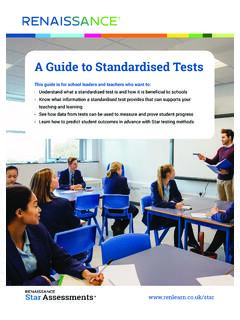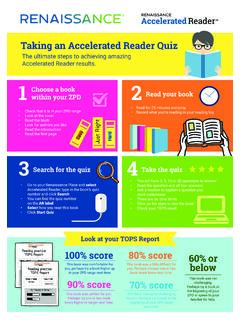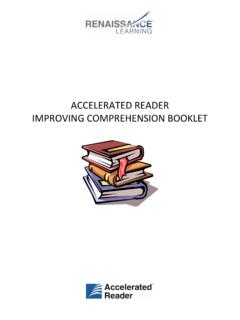Transcription of Getting Results with Accelerated Reader
1 Getting Results with Accelerated Reader What s The Top 10 Tips for Getting Results How to personalise reading practice Scheduling time for reading and quizzing Managing each student s reading practiceand much routines and reading time for reading and quizzing11 When you re each student s reading practice13 Set additional comprehension first19 Enhance practice and analyse data more success the joy of reading23 Appendix322As with all tools, the Results that you and your students achieve with AR will depend on what you do with it. When used casually, AR helps students reading abilities grow. When used thoughtfully and with proven techniques, it leads to tremendous gains and a lifelong love of reading for your students. In this guide, we describe some of the techniques that maximise the potential of AR.
2 The appendix contains step-by-step instructions for the most common software tasks. We hope what you find here will inform and inspire you. Bear in mind, however, that this is only an introduction. To learn more about other Professional Development opportunities, visit our website: ! You have purchased one of the most effective software tools for fostering reading growth - Accelerated Reader (ARTM). 1. Powerful PracticeReading is a skill and, as with every skill, it requires not just instruction but practice. Reading practice serves a number of purposes. It enables students to apply the skills and strategies that you teach. It gives you opportunities to check student learning and identify weaknesses. And it draws students into the world of real reading - a world in which people learn from and enjoy does not automatically lead to growth, however, to be effective, practice must have certain attributes: It must be at the right level of difficulty, cover a sufficient amount of time, be guided by the instructor, and be enjoyable enough to purpose of AR is to enable powerful practice.
3 It does this by: Providing data that helps you monitor and personalise reading practice. Encouraging substantial amounts of practice, according to guidelines based on research findings. Making practice fun for students by facilitating successful encounters with practice to be personalised, there must be a good match between the individual and whatever the individual needs to practice means there must be a way to measure both these elements. Think of working with a personal trainer at the gym: they have to assess your physical capabilities, and they need to understand their exercise equipment so they can recommend a workout that s just right for you. In this way, AR measures students reading capabilities, whilst measuring the equipment available to them - books. In this section, we describe those measurements.
4 In a later section, we ll give you more details on how to use them on a day-to-day conceptsGuided independent reading is an active classroom practice for students and for you, with a number of activities taking place at the same , most students will be reading quietly to themselves. A few students will be taking AR quizzes on either desktop or laptop computers, or on tablets in the classroom. Other students will be selecting a new book to read, either from the classroom library or the school library. Meanwhile, you will be circulating around the room, monitoring, coaching, and intervening. Students who have finished a book will come to you and ask permission to take a quiz. Students who have just taken a quiz will show you the Results so that you can confer with the student, reinforce good work, and provide guidance on which book to choose students read, you will move from individual to individual, checking to see that their books are a good fit, reinforcing concepts and skills you may have taught during a lesson, and showing your interest in them and their efforts.
5 Because you will have established routines for all these things, which we ll describe later in this book, students can work independently and in an orderly and your curriculum4 Zone of Proximal Development (ZPD)Common sense tells us that whenever we practise a skill, we will get the most from our efforts if we work at the right level. Practising with books that are too hard Results in frustration. Practising with books that are too easy does little to improve skills and leads to boredom. with Accelerated Reader (AR), we use the term Zone Of Proximal Development (ZPD) to match students to appropriate books. Based on a concept developed by Russian psychologist Lev Vygotsky, the ZPD represents the level of difficulty that is neither too hard nor too easy, and is the level at which optimal learning takes place. When you begin using AR, you will need baseline data on each student s reading ability in order to estimate a ZPD.
6 Any standardised reading assessment, including STAR ReadingTM, provides this baseline data. STAR Reading also suggests a ZPD for each student. This suggestion is a personalised starting place for reading practice and may need to be adjusted over time. It s just like working with a personal trainer. They will do an initial assessment to get you going. But they will also monitor you closely and make adjustments to your practice routine so that you continuously work within the zone of difficulty that will lead to help you guide students to books that are right for them, we provide three pieces of information about every book for which we have an AR quiz:Book Level represents the difficulty of the text. It is determined by a readability formula called ATOS, which analyses the average length of the sentences in the book, the average length of the words, and the average year level of the Level is based on content - a book s themes and ideas - and indicates for which age group a book is appropriate.
7 In many cases, a book s interest level coordinates with its book level. The Very Hungry Caterpillar by Eric Carle for example, which is suitable for lower-years, has a book level of Many books however, have a low book level but are appropriate for higher years and vice versa. For example, Peter Lancett s The Dark Glass has a book level of because the sentences are short and the vocabulary is simple. The interest level, however, is UY or Upper Years due to the more adult themes dealt with by the story. Daisy Meadow s Ally, The Dolphin Fairy, with an interest level of LY or Lower Years, has a book level of because it contains fairly long words and are assigned to each book based on its length and difficulty. For example, Tony Bradman s Aladdin and the Fabulous Genie is about 3,461 words long, and is a 1-point book.
8 Bad Dreams, by Anne Fine, is about 22,843 words long, and is a 3-point book. Avalon High, by Meg Cabot, about 65,913 words long, is a 10-point book. The formula for calculating points is: AR points = [(10 + book level)/10] x (words in book/10,000).As you work with AR, you will notice that some popular books have more points assigned to them than some classic pieces of literature. Rowling s Harry Potter and the Order of the Phoenix, for example, is a 44 point book while Shakespeare s Macbeth is a 4-point book. Keep in mind that this doesn t mean we think Harry Potter is a better book or more worthwhile to read than Macbeth. Points only tell you that Harry Potter is much longer than Shakespeare s masterpiece Level:Age Appropriateness:Lower Years (LY)Ages 5 to 8 Middle Years (MY)Ages 9 to 13 Upper Years (UY)Ages 14+Book Level, Interest Level and PointsBecause points are based on word count, AR uses them to keep track of how much reading a student has earn points by taking the AR quiz for the book they have just read.
9 If a student reads a 10 point book and scores 100 per cent on the quiz, they earn 100 per cent of the points. If the student scores 90 per cent, they earn 90 per cent of the points, and so on. To earn any amount of points, a student must pass the AR quiz at 60 or 70 per cent. Points make it easy to see how much reading practise a student has successfully completed. For example, a student who has accumulated 50 points has read many more words than a student who has accumulated 10 measures practice with Points5 The purpose of AR is to enable powerful practice. A student s Zone of Proximal Development (ZPD) represents the level of difficulty that is neither too hard nor too easy. Book Level indicates the difficulty of text, not the maturity of content. Interest Level suggests for which Year Levels a book s themes and ideas are appropriate.
10 Points are assigned to a book based primarily on its length. The number of points a student earns tells you how much reading a student has done. The most important factor in accelerating reading growth is good : Accelerated Reader (AR) Key ConceptsIn sports and other competitions, a player wins by earning more points than anybody schools approach AR in the same way and recognise students who earn the most points. We discourage this practice. It s true that a student who has earned a large number of points has done quite a bit of reading, and that s good. But when schools focus primarily on points a couple of things tend to happen: Students choose inappropriate books. In their zeal to earn points and rewards, able readers read dozens of easy low-point books; struggling readers choose high-point books that are too difficult.









